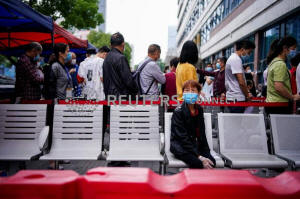Crowds at Wuhan clinics fear coronavirus testing could rekindle disease
 Send a link to a friend
Send a link to a friend
 [May 16, 2020]
By Brenda Goh [May 16, 2020]
By Brenda Goh
WUHAN, China (Reuters) - As Wuhan, the
Chinese city where the COVID-19 pandemic began, revs up a massive
testing campaign, some residents crowding the test centres expressed
concern on Saturday that the very act of getting tested could expose
them to the coronavirus.
Safety has become a hot topic on social media groups among the 11
million residents of Wuhan, people told Reuters as they converged on
open-air test sites at clinics and other facilities. Many said, though,
that they support the voluntary campaign.
Wuhan health authorities sprang back into action after confirming last
weekend the central Chinese city's first cluster of new infections since
it was released from virtual lockdown on April 8.
The new cases - all of them people who had previously shown no symptoms
of the disease - spurred Wuhan authorities to launch a citywide search
for asymptomatic carriers of the virus, aiming to gauge the level of
COVID-19 risk.

Although Wuhan's cinemas and banquet halls remain shut to curb large
gatherings, the testing requires people to wait in long, sometimes
messy, queues.
"Some people have expressed worry in the (social media) groups about the
tests, which require people to cluster, and whether there's any
infection risk," said one Wuhan resident who asked not to be named.
"But others rebutted those worries, saying such comments are not
supportive of the government."
The unprecedented scale of testing indicates the official level of
concern, some experts say. Others say it is an extremely costly exercise
and question its effectiveness.
At a testing kiosk set up at the side of a busy road in Jianghan
district in central Wuhan, a volunteer was patrolling and spraying
disinfectant at a long line of people.
Many people observed social distancing, such as queuing 1 metre apart,
and there were signs to remind them. But just as many did not. In some
cases, volunteer workers were not insisting that they comply.
[to top of second column]
|

A woman wearing a face mask looks on in front of others standing in
a queue for nucleic acid testings in Wuhan, the Chinese city hit
hardest by the coronavirus disease (COVID-19) outbreak, Hubei
province, China May 16, 2020. REUTERS/Aly Song

At another open-air testing kiosk, where throat swabs were taken,
yellow and black stickers on the ground kept people from converging.
But at the back of the long queue, about 40 people gathered with no
guidance from officials or volunteers.
At a third site, a woman who had just reached the front of the queue
quizzed medical workers on whether they had changed their gloves
between each test. When they said they disinfected their gloves but
did not switch them, she said she no longer wanted to take the test.
Residents said the authorities have not told them when they would
get the results of their tests.
To cope with the surge in work, more Wuhan hospitals have been asked
to set up testing points, and other institutions have been roped in
to help process tests, said a doctor involved in the exercise who
asked not to be named as he was not authorised to speak to the
media.
"We are now working 24 hours a day," he said. "There is a lot of
pressure."
China has confirmed 82,941 cases of COVID-19 as of Friday and 4,633
deaths. The government does not include people found to be
asymptomatic carriers of the virus in its tally and does not publish
a cumulative number of asymptomatic cases.
National Health Commission spokesman Mi Feng told reporters 194
asymptomatic carriers were confirmed in the first half of May, down
62% from the second half of April.
(Reporting by Brenda Goh; Writing by Ryan Woo; Editing by William
Mallard)
[© 2020 Thomson Reuters. All rights
reserved.] Copyright 2020 Reuters. All rights reserved. This material may not be published,
broadcast, rewritten or redistributed.
Thompson Reuters is solely responsible for this content.
 |